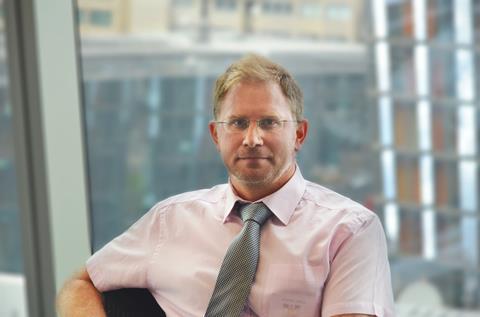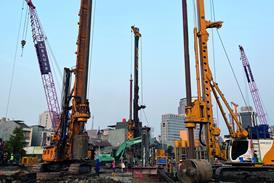Creative solutions are required to deal with some highly constrained sites and deliver much-needed residential development in the capital, says HDR’s Peter Watkins

When considering 21st-century real estate development, dense urban environments always present a huge degree of complexity. London, however, brings a particularly unique set of challenges for building engineers to overcome as they seek to unlock constrained sites for developers, with a significant shortage of available land and high costs alongside a host of other intricacies to consider.
Stepping back to look at the wider landscape, the UK’s acute housing crisis persists, with the government pledging to build 1.5 million new homes in five years and overhauling the planning system to accelerate those goals. Legislative changes such as the Planning and Infrastructure Bill underpin ambitions for a building boom as a key part of economic growth. London’s mayor, meanwhile, has been tasked by Labour to deliver approximately 80,000 new homes annually in the capital.
This raises the question of how to incorporate much-needed new residential and commercial developments into an already highly constrained environment. HDR is helping to unlock the potential of such sites across London and we have experienced first-hand that the way forward requires out-of-the-box thinking and creative solutions.
An innovative building engineering approach
A stand-out example is a complex, multifaceted project at 100 Chalk Farm Road in Camden, which our team is helping to deliver. This will create 264 student accommodation units, 30 affordable homes, sizeable commercial space as well as enhanced public realm.
The site is among the most constrained that I have encountered in my 30-year career, with several engineering difficulties to be resolved simultaneously to enable smooth delivery. Most notably, the scheme is next to the grade II listed, iconic Roundhouse building, necessitating careful consideration and meticulous planning to respect and complement the surrounding architecture and overall area. The new additions will feature three circular towers (mirroring the shape of the adjacent Roundhouse) rising to a maximum of 12 storeys.
Making this scheme viable involves many moving parts and a comprehensive, co-ordinated approach, with preparations commencing months in advance
Aside from working next to a building of exceptional historic interest, there is also a live Network Rail freight line at the back of the site, an Underground Northern line tunnel in close proximity, and a Thames Water main tunnel directly underneath. To offset the sounds and vibrations of the trains, we will utilise vibration isolation bearings under the buildings.
Making this scheme viable involves many moving parts and a comprehensive, co-ordinated approach, with preparations commencing months in advance. Measures included undertaking extensive ground movement assessments and liaising with several different regulatory authorities simultaneously, each with its own approvals process and timings.
Understanding a truly unique, multilayered city
There are many unusual and unexpected elements in London and, unlike other cities, several of these may be combined on any given project. Engineering teams can expect to deal with everything from historic docks, archaeological digs, brownfield sites and contaminated land, to flood risks, gas mains, rivers and canals, deep basements, overhead power lines and much more.
On another interesting site that is near completion in Wembley, we had to build over the top of a 15m-deep replica coalmine originally constructed for the 1924 British Empire exhibition. In this instance, we had to undertake detailed surveys and investigations to establish the parameters of the mine so that we could effectively build around the replica coalmine.
Elsewhere, projects have called for in-depth analysis of geological, sewer and utility records; tunnels, gas mains and flood risk maps; and historic records such as Second World War unexploded ordnance searches. What is more, design must integrate aspects like blast design assessments, in line with the Counter Terror Security Agency, for robust safety and resilience in the modern era.
Any project starts with understanding and appreciating this city, which is fascinating because of what is visible above ground and also what is unseen or hidden underground. One major differentiator is its geological make-up, especially the unique qualities of London clay, which shrinks or heaves depending on conditions and factors such as trees drawing moisture. This affects the planning of foundations and any developments, making the risk of subsidence issues more common, too.
When it comes to successfully navigating the complexities of London development, early engagement is crucial between all parties, to identify and resolve any constraints early on to meet client deadlines and budgets. Reviewing historic records and conducting detailed research to gain a full and accurate picture, is critical from the outset.
There have been many examples of Roman and medieval artefacts being found as works have commenced and, as such, the commissioning of archaeological surveys is paramount, and indeed is part of the planning process, as are numerous other survey requirements.
Ultimately, it comes down to taking a thoughtful approach that encompasses a long-term vision while respecting the fabric of the city and its extraordinary heritage
Certainly, any approach should by default remain rigorous and aligned with the highest quality, building safety and sustainability standards, not least the broader 2050 net zero targets. However, it is important to recognise that every site is different and requires a creative, flexible and tailored (rather than one-size-fits-all) solution that best responds to its context and needs.
Unlocking complicated sites drives considerable value for developer clients and, as practitioners within the built environment, we also have a responsibility to deliver societal and environmental value through placemaking strategies, for the betterment of neighbourhoods and thriving communities. After all, some of London’s most successful urban regeneration projects are now destinations in their own right, such as King’s Cross and Canary Wharf.
Ultimately, it comes down to taking a thoughtful approach that encompasses a long-term vision while respecting the fabric of the city and its extraordinary heritage, helping to create a positive legacy for future generations.
Peter Watkins is director of engineering at HDR























No comments yet